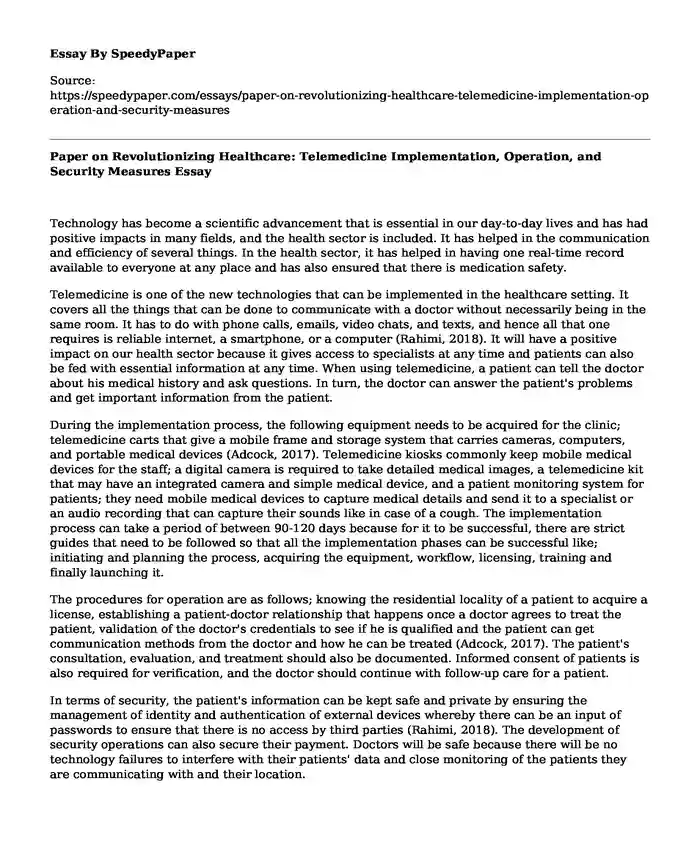
| Type of paper: | Essay |
| Categories: | Health and Social Care Technology Security |
| Pages: | 3 |
| Wordcount: | 755 words |
Technology has become a scientific advancement that is essential in our day-to-day lives and has had positive impacts in many fields, and the health sector is included. It has helped in the communication and efficiency of several things. In the health sector, it has helped in having one real-time record available to everyone at any place and has also ensured that there is medication safety.
Telemedicine is one of the new technologies that can be implemented in the healthcare setting. It covers all the things that can be done to communicate with a doctor without necessarily being in the same room. It has to do with phone calls, emails, video chats, and texts, and hence all that one requires is reliable internet, a smartphone, or a computer (Rahimi, 2018). It will have a positive impact on our health sector because it gives access to specialists at any time and patients can also be fed with essential information at any time. When using telemedicine, a patient can tell the doctor about his medical history and ask questions. In turn, the doctor can answer the patient's problems and get important information from the patient.
During the implementation process, the following equipment needs to be acquired for the clinic; telemedicine carts that give a mobile frame and storage system that carries cameras, computers, and portable medical devices (Adcock, 2017). Telemedicine kiosks commonly keep mobile medical devices for the staff; a digital camera is required to take detailed medical images, a telemedicine kit that may have an integrated camera and simple medical device, and a patient monitoring system for patients; they need mobile medical devices to capture medical details and send it to a specialist or an audio recording that can capture their sounds like in case of a cough. The implementation process can take a period of between 90-120 days because for it to be successful, there are strict guides that need to be followed so that all the implementation phases can be successful like; initiating and planning the process, acquiring the equipment, workflow, licensing, training and finally launching it.
The procedures for operation are as follows; knowing the residential locality of a patient to acquire a license, establishing a patient-doctor relationship that happens once a doctor agrees to treat the patient, validation of the doctor's credentials to see if he is qualified and the patient can get communication methods from the doctor and how he can be treated (Adcock, 2017). The patient's consultation, evaluation, and treatment should also be documented. Informed consent of patients is also required for verification, and the doctor should continue with follow-up care for a patient.
In terms of security, the patient's information can be kept safe and private by ensuring the management of identity and authentication of external devices whereby there can be an input of passwords to ensure that there is no access by third parties (Rahimi, 2018). The development of security operations can also secure their payment. Doctors will be safe because there will be no technology failures to interfere with their patients' data and close monitoring of the patients they are communicating with and their location.
Resources that will be needed are PlushCare, a website where all the telemedicine information will be available. In PlushCare, there will be descriptions of the offers that the doctor avails, like treatment of thyroid imbalance, headaches, pink eyes, or cold and flu. Patients' frequently asked questions will also be needed where the queries question by patients will be shown (Rahimi, 2018). There will also be articles like PDFs that will show all information about telemedicine.
During training, all relevant staff will be included, like clinicians and the IT staff, where there can be a power user appointment that can help other staff members when they have questions. A list of technical faqs will also be made to be accessed by any staff at any time (Rahimi, 2018). Staff will be required to do practice runs to log into the leap to look around and familiarize themselves with it or work with simulation patients. Patients will be trained by being given guidelines on how it should be used and how they can access the required websites.
References
Adcock, A. K., Kosiorek, H., Parikh, P., Chauncey, A., Wu, Q., & Demaerschalk, B. M. (2017). Reliability of robotic telemedicine for assessing critically ill patients with the full outline of unresponsiveness score and Glasgow coma scale. Telemedicine and e-Health, 23(7), 555-560.
Rahimi, B., Nadri, H., Afshar, H. L., & Timpka, T. (2018). A systematic review of the technology acceptance model in health informatics. Applied clinical informatics, 9(3), 604
Cite this page
Paper on Revolutionizing Healthcare: Telemedicine Implementation, Operation, and Security Measures. (2024, Jan 18). Retrieved from https://speedypaper.com/essays/paper-on-revolutionizing-healthcare-telemedicine-implementation-operation-and-security-measures
Request Removal
If you are the original author of this essay and no longer wish to have it published on the SpeedyPaper website, please click below to request its removal:
- Aging Surfer Case Essay
- Why Are Americans Rapidly Becoming More Obese? Free Essay
- Essay Example: Health Disparities of the Kenyan Population
- Essay Sample on Emerging Technological Trend
- Essay Sample on Schizophrenia
- Introduction of Law Enforcement Officer Use of Excessive Force
- Unveiling Healthcare's Evolution: From Gender Roles to Sociopolitical Challenges
Popular categories




